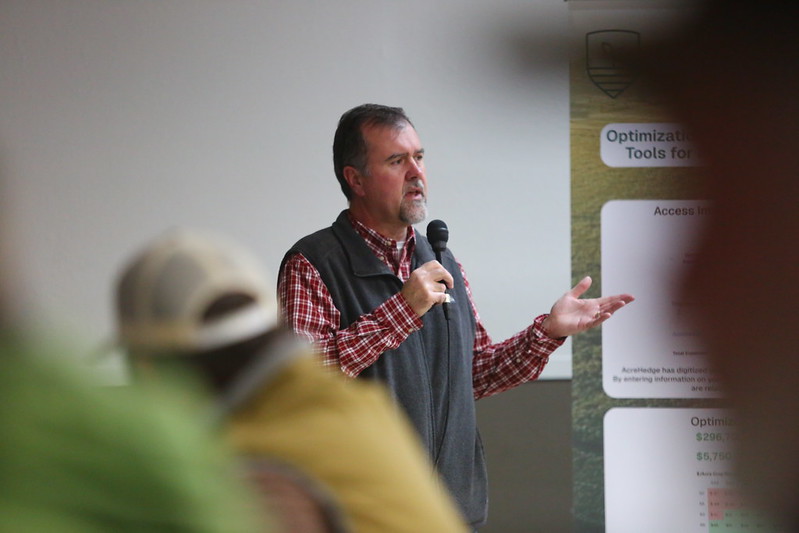Arkansas growers face headwinds in 2025
Jan. 13, 2025
By Ryan McGeeney
U of A System Division of Agriculture
Fast Facts:
- Low commodity prices undercut high 2024 yields
- Success in 2025 will come down to efficiency
- See winter production meeting schedule online
(532 words)
(Newsrooms: Download photos from last week’s production meeting)
MORRILTON, Ark. — Despite record yields in 2024, many growers in Arkansas ended the year in the red. Facing continued high input prices, low commodity prices and the possible resumption of a trade war with China, 2025 will likely prove just as challenging.
Ronnie Cross, a Yell County row crop farmer, was one of about 50 growers, consultants and other agriculture industry professionals to attend the University of Arkansas System Division of Agriculture’s first winter production meeting of the year in Morrilton on Jan. 9. Asked how 2024 treated his farming operation, Cross answered with a sigh.
“OK,” he said. “Not spectacular.”
Like many experienced farmers in Arkansas and elsewhere, Cross saw great yields in his corn crop, but was thwarted with low commodity prices in the marketplace.
“Inputs costs were up, too, of course, but that seems to be the trend,” Cross said. “So it was pretty much a break-even year, and we call that a good year.”
In most ways, Cross’ experience is indicative of many Arkansas producers’ efforts. 2024 saw a record average yield for Arkansas soybeans and a second-highest average yield for corn. And yet, for many growers, 2025 will be more of a matter of survival, said Division of Agriculture soybean agronomist Jeremy Ross.
“As far as production goes, 2024 was good,” Ross said. “Commodity-pricewise, it was really bad. Prices we haven’t seen in 30, 40 years. And production costs weren’t the same as they were 30-40 years ago — they’re elevated.
“So even though some farmers may have had the best crop year they’ve ever had, they’re struggling just to pay their loans and keep going,” Ross said.
The Jan. 9 meeting featured presentations from Ross, extension wheat and feed grains agronomist Jason Kelley and agricultural economists Scott Stiles and Hunter Biram. Ross said that for growers to give themselves their best shot at succeeding in 2025, they should focus on the things they can control, including irrigation, variety selection and other best management practices.
Over the course of 2024, soybean commodity prices averaged $10.03 per bushel, well under the average $14.20 paid in 2022 and $12.55 in 2023. While use of soybean in feed, bio-diesel and exports — primarily to China — were all strong, supply from South American countries such as Brazil and Argentina kept world stocks ahead of demand. The U.S. Department of Agriculture currently projects world soybean stocks to reach 131.87 million metric tons by the end of the 2024/2025 marketing year.
Ross said commodity prices are likely to be even lower this year than in 2024.
“If you’re already kind of behind the eight ball, it’s going to be a struggle just to survive 2025,” he said.
Corn growers are in a similar situation, with elevated input costs and suppressed commodity prices, said Kelley.
“Just like everyone else’s everyday expenses, from insurance to groceries, have gone up, farmers are in the same boat: Insurance, fuel, oil, labor — all the inputs have gone up drastically in the last five years,” Kelley said. “And while the prices growers receive for the grain is pretty flat, $4-and-something for corn, we were getting that 10 years ago. Ten years ago, that wasn’t too bad. Today, it’s really not enough.”
To learn about extension programs in Arkansas, contact your local Cooperative Extension Service agent or visit www.uaex.uada.edu. Follow us on X and Instagram at @AR_Extension. To learn more about Division of Agriculture research, visit the Arkansas Agricultural Experiment Station website: https://aaes.uada.edu/. Follow on X at @ArkAgResearch. To learn more about the Division of Agriculture, visit https://uada.edu/. Follow us on X at @AgInArk.
About the Division of Agriculture
The University of Arkansas System Division of Agriculture’s mission is to strengthen agriculture, communities, and families by connecting trusted research to the adoption of best practices. Through the Agricultural Experiment Station and the Cooperative Extension Service, the Division of Agriculture conducts research and extension work within the nation’s historic land grant education system.
The Division of Agriculture is one of 20 entities within the University of Arkansas System. It has offices in all 75 counties in Arkansas and faculty on three campuses.
Pursuant to 7 CFR § 15.3, the University of Arkansas System Division of Agriculture offers all its Extension and Research programs and services (including employment) without regard to race, color, sex, national origin, religion, age, disability, marital or veteran status, genetic information, sexual preference, pregnancy or any other legally protected status, and is an equal opportunity institution.
# # #
Media Contact:
Ryan McGeeney
rmcgeeney@uada.edu
@Ryan_McG44
501-671-2120
